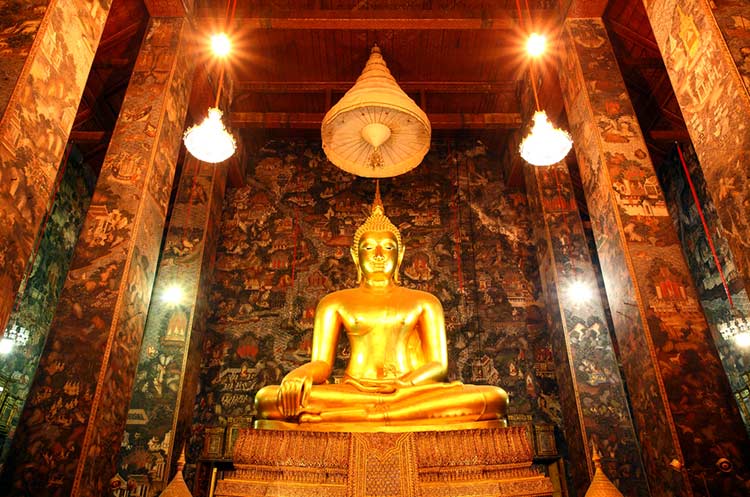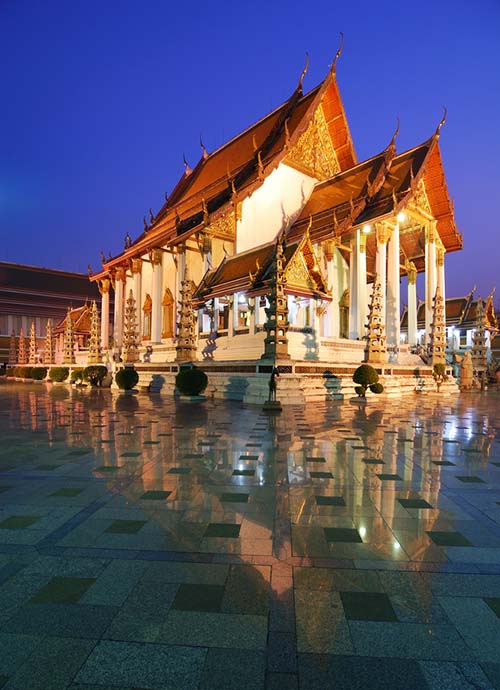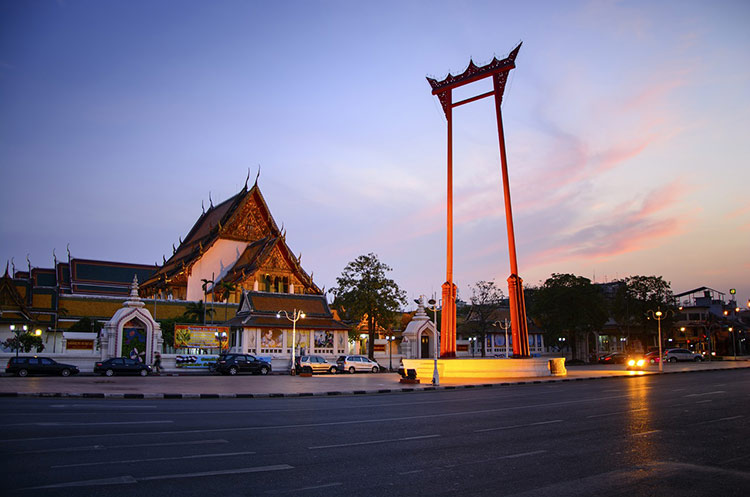
Wat Suthat
Temple of the Giant Swing
Bangkok
The Wat Suthat is one of the most important and one of the oldest temples of the Rattanakosin era in Bangkok. It is one of the six temples in Thailand of the highest grade of the first class Royal temples.
When Rama I became the first ruler of the Rattanakosin Kingdom in 1782, he ordered the construction of the Wat Suthat. Construction lasted for decades, and the Wat was finally finished during the reign of King Rama III in 1847.
One of the largest in Bangkok
The temple complex which is officially named Wat Suthat Thepphawararam is one of the largest in Bangkok covering 10 acres.
8 meter tall Buddha image
The viharn of the Wat Suthat is one of the oldest Rattanakosin era buildings still in existence. It holds the most important Buddha image of the Wat.
800 Year old Sukhothai image
The Phra Si Sakyamuni is a eight meter tall bronze Buddha image in subduing Mara posture. It was cast in Sukhothai some 800 years ago and was brought over to Bangkok from an abandoned temple in Sukhothai by river boat.
When the image arrived in Bangkok, festivities that lasted a week were organized and the Buddha image was paraded through Bangkok. Underneath the image the ashes of King Ananda Mahidol, Rama VIII the older brother of the current King are buried.

Magnificent murals in the viharn
The long walls of the viharn contain magnificent mural paintings telling the stories of the previous lives of the Buddha. Some also show scenes of daily life in the Rattanakosin era. These murals and those in the Grand Palace are some of the best and most extensive to be found in Thailand.
The wooden carved entry doors to the viharn contain similar paintings, some of which were made by King Rama II, who was a talented poet and artist.
In the galleries surrounding the viharn you will find a display of more than 150 large Buddha images.
Other buildings and courtyard
The temple complex also contains a large ubosot or ordination hall and a Sala Kan Parian, which is a sala used to teach Buddhist teachings, as well as the monks living quarters.
The wide courtyard contains a large number of stone statues brought over from China around the end of the 18th century.

The giant swing
The Wat Suthat is also known as the temple of the giant swing, after the huge red swing in front of it called Sao Ching Chaa. The teak wood 20 meter high swing that was built at the end of the 18th century was used in annual Brahmanic ceremonies.
Groups of young men competed with each other trying to swing high enough to grab with their teeth a bag of gold coins that was attached to a pole. Some men would swing well over 20 meters in the air. After a number of fatal accidents, the swing ceremony was cancelled in the 1930’s.
UNESCO World Heritage Site
The Wat Suthat and the Giant Swing have been submitted to UNESCO for evaluation as future World Heritage Site.
Location
Wat Suthat is located on Thanon Bamrung Muang in the old city, about one kilometer East of the Grand Palace.
Also visit nearby Wat Ratchanadda, Fort Mahakan and Wat Saket, also known as the temple of the Golden Mount.
How to get to the Wat Suthat
There is no BTS Skytrain station nearby.
The nearest MRT Subway station is Sam Yot, about 450 meters South of Wat Suthat.
Otherwise get there by metered taxi or by tuk tuk, depending on the distance.
Opening hours
The Wat Suthat temple complex is open daily from 9 am until 6 pm.
Entrance fee
Admission is 20 Thai Baht.
Nearby attractions
- Wat Ratchanadda Metal Castle
- Wat Saket Golden Mount temple
- Fort Mahakan
- Rattanakosin historical district
- MRT Subway Sam Yot station